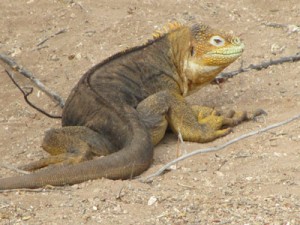In a land of innocence
View(s):Charles Darwin said about his visit here ¨these islands appear to be a world within themselves – a perennial source of new things”.

Picture of co-existence: Crab, iguana and bird
Situated in the Pacific Ocean some 900 km off the west coast of Ecuador in South America, these were the “Enchanted Islands¨ where in 1835 Darwin made astute observations about natural selection and evolution that culminated in his famous publication The Origin of Species – one of the major landmarks in modern scientific thought that radically changed the world’s ideas about creation and nature.
Born of volcanic eruptions in the Pacific Ocean, the ancient Galápagos Islands have with the passage of time acquired plants and animals which, isolated from the large continental landmasses, have evolved into exotic life forms quite different to their mainland cousins.
Without mammalian predators to harass them, tortoises on these islands evolved into gigantic creatures with long legs and necks that allow them to feed off metre-high plants.
With abundant fish in the waters off the coast, cormorants here have evolved into species with vestigeal wings, trading their wings and keeled breastbones for more streamlined bodies better suited to swimming underwater.
These flightless cormorants have over generations lost the power of flight. Food being plentiful here, they no longer need to fly to find food – they simply swim into the sea and catch fish underwater!

The king of the island: A giant tortoise
Iguanas here have evolved over time, adapting themselves to the availability of foods quite different to the diet of their land cousins. The marine iguanas of the Galápagos Islands, adapted to swim underwater, feed solely on seaweed.
Visitors to the islands will see huge lizards going about their activities of daily living with little concern for humans or their clicking cameras – and sea lions so unafraid of visitors that they lie languidly on the beach suckling their young, or swim past you when you are taking a dip in the shallow waters.
The fourteen species of finches on the different islands all descended from a common ancestor – but have gradually evolved into different species with different shaped beaks, modified over time to suit the particular type of food that is plentiful in their particular habitat.
The islands harbour a plethora of birds – pelicans, flamingos, fairy penguins, blue-footed boobies (yes, they actually do have bright blue feet!) as well as large male frigate birds that puff out their red throats like balloons to attract passing females.
Designated a protected natural reserve and a UNESCO world heritage site, the islands are home to some unique animals – but what is more, these are animals that are uniquely unafraid and approachable.

Small and bold: An island bird checks out a visitor
We were able to swim among fish and even the occasional friendly sea lion off the isolated beaches (but beware – even though this is in the tropics, the waters are cold!).
Galápagos means ‘tortoise’ in Spanish – and we made sure we did not miss seeing these giant animals, some individuals over a hundred years old and weighing over 200 kilograms.
Visitors to the islands are restricted, the Ecuadorean Park Service maintaining a strict quota – so it is best to arrange your visit through a tour company.
The best option is to go on a seven or ten day cruise so you sleep on board while the ship travels between the islands; you then have the opportunity to undertake excursions to the different islands during the day with trained naturalist guides.
You can fly into the islands from either Ecuador’s capital Quito or Guayaquil the major commercial centre.
Coming here on a visit will ensure that your understanding of the natural world takes on an entirely different perspective – carrying you back to the natural world, to a genuine wilderness where animals live in a state of innocence, lying languidly on the beach or in your path completely ignoring photo-catching visitors with their iPads, phones and cameras.

Minding its own business: A land iguana
Sea lions, giant tortoises, marine iguanas and a variety of birds thrive here in a balance of nature that has existed for thousands of years without Man – and without the fear of Man.
A visit to the Galàpagos Islands is a once-in-a-lifetime adventure to a naturalist´s paradise where the animals are unique – and uniquely approachable.
For more information, see http://www.galapagospark.org/


